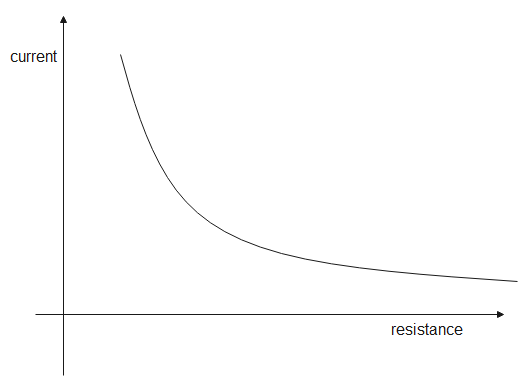
How does the resistance affect the current in a circuit?
Answer
475.5k+ views
Hint: Current in a circuit flows from one point to the other when there exists a potential difference between the points. Resistance opposes the flow of current. The relationship between potential difference, current and resistance of a circuit is given by the ohm’s law. At constant voltage, we can determine the relation between current and resistance.
Complete answer:
The resistance is the property of a material by virtue of which it resists the flow of current through it. Its SI unit is ohms (
According to the ohm's law,
Here,
From the above equation we can see that current is inversely proportional to the resistance in the circuit. Therefore,
This means as the resistance increases, the current decreases and vice versa. The graph between current and resistance is shown in the figure below

The graph shows the inverse relation between current and resistance. The slope of the graph will be negative.
Therefore, current is inversely proportional to the resistance; current decreases with increase in resistance and vice versa.
Note:
The relationship between current and resistance is true when the potential difference is constant. The resistance depends on the temperature and nature of material. The insulators have the highest resistance, semiconductors have a lower resistance and the conductors have the lowest resistance. With increase in temperature, the resistance of insulators and semiconductors decreases but the resistance of conductors increases.
Complete answer:
The resistance is the property of a material by virtue of which it resists the flow of current through it. Its SI unit is ohms (
According to the ohm's law,
Here,
From the above equation we can see that current is inversely proportional to the resistance in the circuit. Therefore,
This means as the resistance increases, the current decreases and vice versa. The graph between current and resistance is shown in the figure below

The graph shows the inverse relation between current and resistance. The slope of the graph will be negative.
Therefore, current is inversely proportional to the resistance; current decreases with increase in resistance and vice versa.
Note:
The relationship between current and resistance is true when the potential difference is constant. The resistance depends on the temperature and nature of material. The insulators have the highest resistance, semiconductors have a lower resistance and the conductors have the lowest resistance. With increase in temperature, the resistance of insulators and semiconductors decreases but the resistance of conductors increases.
Recently Updated Pages
Master Class 11 Economics: Engaging Questions & Answers for Success

Master Class 11 Business Studies: Engaging Questions & Answers for Success

Master Class 11 Accountancy: Engaging Questions & Answers for Success

Master Class 11 English: Engaging Questions & Answers for Success

Master Class 11 Computer Science: Engaging Questions & Answers for Success

Master Class 11 Maths: Engaging Questions & Answers for Success

Trending doubts
Which one is a true fish A Jellyfish B Starfish C Dogfish class 11 biology CBSE

State and prove Bernoullis theorem class 11 physics CBSE

1 ton equals to A 100 kg B 1000 kg C 10 kg D 10000 class 11 physics CBSE

In which part of the body the blood is purified oxygenation class 11 biology CBSE

One Metric ton is equal to kg A 10000 B 1000 C 100 class 11 physics CBSE

Difference Between Prokaryotic Cells and Eukaryotic Cells




